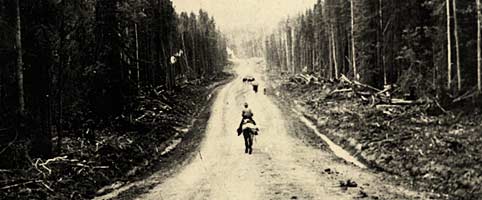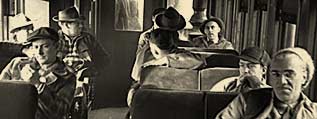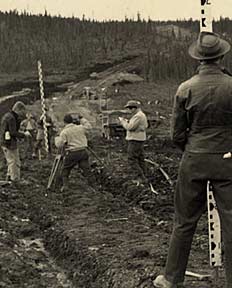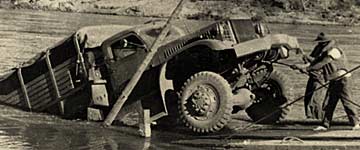
Operation Alaska Highway
"Built through the Canada’s Wilderness by a Welcome Invasion Army of US Soldiers." A horse and rider traveling on the newly constructed Alaska Highway. ca. 1942.
(view more details)
(view more details)

"Winding in and winding out,
leaves my mind in serious doubt,
as to whether the lout who built this route,
was going to Hell or coming out."
-Anon.
leaves my mind in serious doubt,
as to whether the lout who built this route,
was going to Hell or coming out."
-Anon.
The interior of a White Pass railway coach at Skagway. (view more details)

The meandering character of the Alaska Highway belied the speed and determination with which it was built. Ten thousand U.S. Army Engineers and six thousand civilians, hired by the U.S. Public Roads Administration, had orders to push a 1700 mile pioneer road through the north in the space of one season – from thaw to freeze-up. This tight time frame required a "quick and dirty" approach to road-building unheard of during peace-time. The planning stage was extremely short, little was known about the route, and there was little opportunity to learn. Once funds were allocated, troops had slightly over one month to mobilize. The construction was full of difficulties and challenges, from getting supplies to surveying northern terrain to dealing with permafrost. An additional challenge was that the U.S. Army and the Public Roads Administration revised the project several times during the eight months of construction.
A Public Roads Administration survey crew working alongside trucks and bulldozers closing the last gap in the permanent Alaska Highway, October 13, 1943.(view more details)

The highway project grew to include the Canol road, pipeline and refinery as well as the upgrading of airports, the addition of airstrips, and the construction of the Haines Road and telephone lines. The original plan to build two parallel highways was abandoned in favour of pushing through one road capable of carrying freight – a "tote" road completed by the US army in 1942. Between 1942 and 1944, the Public Roads Administration contracted more than eighty privately owned companies to upgrade the "tote" road and airports, and to build permanent bridges. There were approximately 8,000 civilian contractors working in 1942 and 14,000 in 1943. Much was learned about highway construction in northern climates from the Alaska Highway and Canol projects, from the initial stages of construction through a half-century of rebuilding and maintenance.


